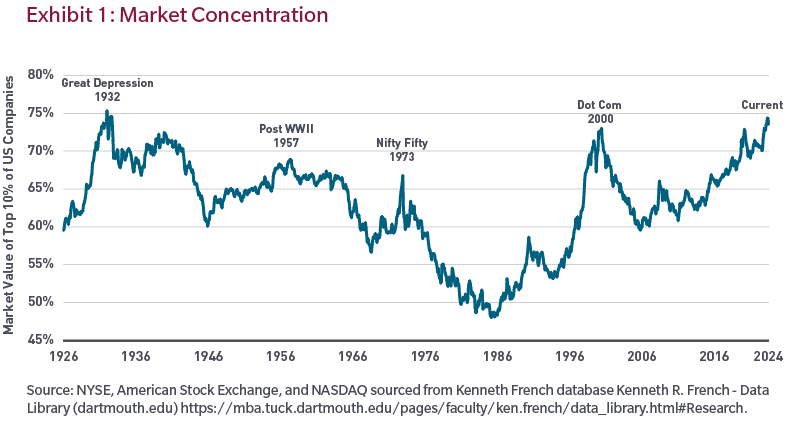Exhibit 3 displays the average annualized and cumulative results after the peak in concentration over various timeframes for the following: US equal-weighted index less US cap-weighted index; US small cap less US large cap; US value less US growth. The rightmost dataset indicates the average results across the entire diversification cycle, as indicated from a peak to trough in market concentration.
As shown, the better performing areas of the equity market during a diversification cycle are historically the ones that have been the laggards over the past many years — and by a wide margin. Specifically, as shown in Exhibit 3, note the following:
- Breadth: Equal-weighted equities significantly outperformed cap-weighted equities. Following periods of excessive concentration, more diversified portfolios (i.e., equal-weighted portfolios) historically outperformed the more concentrated cap-weighed portfolios. This could bode well for active managers who are typically more diversified than the current cap-weighted indices. By definition, traditional passive portfolios carry equivalent allocations to stocks as the indexes they track. With a small subset of highly performing stocks representing a significant percentage of large-cap indices, any pressure on these stocks could subject passive portfolios to substantial downside risk. Active managers have the flexibility to prudently diversify away from the risk of excessive concentration in their benchmarks.
- Size: Small caps outperformed large caps. Investors may be leaving returns on the table by not diversifying down the market cap spectrum. Additionally, this may bode well for some active managers given the skew of large-cap indexes as well as the potential opportunity to take active positions in an area of the market that is less covered, less efficient and may possess a greater opportunity to drive value through security selection.
- Style: Value outperformed growth. Much like size, investors may be better served by diversifying their style exposures. Clearly growth has had a tailwind recently, but ensuring style diversification can help manage the return profile when growth eventually fades.
Of course no one can perfectly time when concentration will peak, but the encouraging element to note is that it is not critically important in our view. Our analysis showed directionally similar outcomes when measured from a starting point one and two years preceding market concentration peaks. Even if you are early, we believe the benefits of diversification can be meaningful when the cycle turns. Our conclusion here is that ensuring proper diversification is more critical than the actual timing of diversification.
Conclusion – An Argument for Diversification
Given substantial market strength over the last decade, largely from just one market segment, it’s easy to fall into the trap of forgetting about the benefits of diversification. The history books may describe the theme of the past decade-plus as a period of extreme market concentration and strong performance of a small segment of the investable universe. We don’t know when this regime will end, but the data show evidence that when market leadership changes, the shifts can be as dramatic and persist for just as long — historically benefiting a diversified and active approach.
Endnotes
1 S&P 500 Top 50 – Gross return.
2 Russell 2000® – Total Return.
3 Russell 3000® Growth – Total Return.
4 Russell 3000® Value – Total Return.
5 NYSE, American Stock Exchange, and NASDAQ sourced from Kenneth French database Kenneth R. French - Data Library (dartmouth.edu) https://mba.tuck.dartmouth.edu/pages/faculty/ken.french/data_library.html#Research.
“Standard & Poor’s®” and S&P “S&P®” are registered trademarks of Standard & Poor’s Financial Services LLC (“S&P”) and Dow Jones is a registered trademark of Dow Jones Trademark Holdings LLC (“Dow Jones”) and have been licensed for use by S&P Dow Jones Indices LLC and sublicensed for certain purposes by MFS. The S&P 500® is a product of S&P Dow Jones Indices LLC, and has been licensed for use by MFS. MFS’ Products are not sponsored, endorsed, sold or promoted by S&P Dow Jones Indices LLC, Dow Jones, S&P, or their respective affi liates, and neither S&P Dow Jones Indices LLC, Dow Jones, S&P, their respective affi liates make any representation regarding the advisability of investing in such products.
Frank Russell Company (“Russell”) is the source and owner of the Russell Index data contained or refl ected in this material and all trademarks, service marks and copyrights related to the Russell Indexes. Russell® is a trademark of Frank Russell Company. Neither Russell nor its licensors accept any liability for any errors or omissions in the Russell Indexes and/or Russell ratings or underlying data and no party may rely on any Russell Indexes and/or Russell ratings and/or underlying data contained in this communication. No further distribution of Russell Data is permitted without Russell’s express written consent. Russell does not promote, sponsor or endorse the content of this communication.
The views expressed are those of the author(s) and are subject to change at any time. These views are for informational purposes only and should not be relied upon as a recommendation to purchase any security or as a solicitation or investment advice. No forecasts can be guaranteed. Past performance is no guarantee of future results.
Diversification does not guarantee a profit or protect against a loss.



